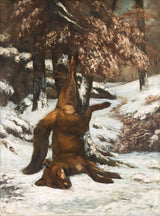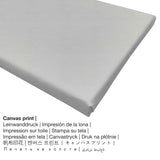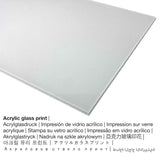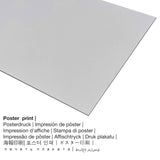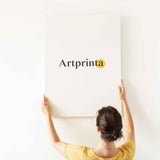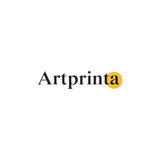Gustave Courbet - Fox nwụrụ anwụ - mbipụta nka mara mma
Ụtụ gụnyere. Mbupu gbakọrọ na ndenye ọpụpụ.
Nhọrọ ihe enwere ike
Maka mbipụta nka ọ bụla anyị na-enye ihe & nha dị iche iche. Ya mere, anyị na-enye gị ohere ịhọrọ n'ime nhọrọ ndị a:
- Mbipụta kwaaji: The canvas direct print is a printed cotton canvas mounted on a wooden frame. Your canvas of this artpiece will allow you to transform your into a large artpiece. Canvas Prints have the advantage of being relatively low in weight. That means, it is easy and straightforward to hang up the Canvas print without the use of additional wall-mounts. Therefore, canvas prints are suited for all kinds of walls.
- Ihe odide acrylic glass: An acrylic glass print, which is sometimes denoted as a plexiglass print, will change the original work of art into stunning home décor. Your artwork is being made with modern UV direct print machines.
- Mbipụta akwụkwọ mmado (ihe kwaaji): Our poster is a UV printed sheet of flat canvas paper with a slightly roughened finish on the surface, which resembles the actual artwork. Please note, that depending on the size of the poster we add a white margin of something between 2-6cm around the work of art, which facilitates the framing with your custom frame.
- Aluminom dibond (ọkpụkpụ ọla): These are metal prints on aluminium dibond with an outstanding effect of depth. The bright components of the artpiece shimmer with a silky gloss but without glow. The colors are bright and luminous, fine details are crisp.
Ederede iwu dị mkpa: We try our utmost in order to describe our products with as many details as possible and to exhibit them visually. However, the tone of the print products, as well as the imprint may diverge marginally from the representation on your device's monitor. Depending on your settings of your screen and the condition of the surface, color pigments may not be printed one hundret percent realistically. Given that all the art prints are processed and printed by hand, there might as well be slight differences in the size and exact position of the motif.
Artwork depiction by Nationalmuseum Stockholm (© Copyright - by Nationalmuseum Stockholm - www.nationalmuseum.se)
English: During the Second Empire (1852–1870) hunting became a popular sport, not only for the aristocracy but also for the wealthy bourgeoisie. The art market in Paris was inundated with requests for hunting scenes. Courbet’s paintings on this theme were in great demand. He himself was a passionate hunter and his paintings are characterized by a high degree of realism in the portrayal of animals, nature and the various elements of the hunt. The snowy landscape in several of these works was often painted outdoors – although the dead fox was painted in the studio. Under det andra kejsardömet (1852–1870) blev jakt ett omtyckt nöje, inte bara för aristokratin, utan även inom det förmögna borgerskapet. På konstmarknaden i Paris uppstod en stor efterfrågan på jaktbilder. Courbets målningar på detta tema blev också omåttligt populära. Han var själv en passionerad jägare och hans målningar präglas av en långt driven realism i skildringen av djuren, naturen och jaktens olika moment. De snölandskap som framträder i dessa målningar var ofta som här utförda ute i det fria – även om den döda räven målats i ateljén.
Ngwaahịa nka nke onwe gị
Ndị na-ese ihe osise a onye n’ezie nwe- Gustave Courbet kwuru. E ji nha ya see nke mbụ ya: Ogologo: 134 cm (52,7 ″); Obosara: 100 cm (39,3 ″) Ekebere: Elu: 170 cm (66,9 ″); Obosara: 137 cm (53,9 ″); Omimi: 13 cm (5,1 ″) wee jiri teknụzụ mepụta ya mmanụ na kwaaji. The artwork is part of the art collection of National Museum nke Stockholm. a ngalaba ọha masterpiece is included with courtesy of Nationalmuseum Stockholm & Wikimedia Commons.Creditline of the artwork: . What is more, the alignment of the digital reproduction is portrait with an aspect ratio of 3: 4, nke pụtara na ogologo bụ 25% mkpụmkpụ karịa obosara. Gustave Courbet was a male painter, sculptor, communard from France, whose art style can be classified as Realism. The Realist painter lived for 58 afọ a mụrụ ya n'afọ 1819 na Ornans, Bourgogne-Franche-Comte, France wee nwụọ na 1877.
Ozi ndabere na ọrụ nka mbụ
| Iberibe aha nka: | "The Dead Fox" |
| Nhazi nka: | sere |
| Usoro izizi: | mmanụ na kwaaji |
| Nha nke ihe osise izizi: | Ogologo: 134 cm (52,7 ″); Obosara: 100 cm (39,3 ″) Ekebere: Elu: 170 cm (66,9 ″); Obosara: 137 cm (53,9 ″); Omimi: 13 cm (5,1 ″) |
| Ụlọ ihe ngosi nka / ebe: | National Museum nke Stockholm |
| Ebe ngosi nka: | Stockholm, Obodo Stockholm, Sweden |
| Weebụsaịtị nke ihe ngosi nka: | National Museum nke Stockholm |
| Ikikere nke ihe osise: | ngalaba ọha |
| Site n'aka: | Nationalmuseum Stockholm na Wikimedia Commons |
Banyere ngwaahịa
| Nkewa edemede: | ezi nka mmeputakwa |
| Usoro mmeputakwa: | mmeputakwa n'ụdị dijitalụ |
| Usoro mmepụta: | mbipụta dijitalụ (Mbipụta UV ozugbo) |
| Ihe ngosi: | German mere |
| Ụdị ngwaahịa: | mmepụta ihe na-achọ |
| Ihe eji eme atụmatụ: | foto mgbidi, ụlọ ihe osise nka |
| Ndozi onyonyo: | usoro eserese |
| Njikwa oyiyi: | 3:4- (ogologo: obosara) |
| Ihe: | ogologo bụ 25% mkpụmkpụ karịa obosara |
| Nhọrọ akwa: | Mbipụta iko acrylic (nwere ezigbo mkpuchi iko), mbipụta ọla (aluminium dibond), mbipụta akwa akwa, mbipụta akwụkwọ mmado (akwụkwọ kwaaji) |
| Nhọrọ nha nha mbipụta kanvas (akwa akwa na etiti ihe ndọtị): | 30x40cm - 12x16", 60x80cm - 24x31", 90x120cm - 35x47", 120x160cm - 47x63" |
| Mbipụta iko acrylic (nwere ezigbo mkpuchi iko) nhọrọ nha: | 30x40cm - 12x16", 60x80cm - 24x31", 90x120cm - 35x47", 120x160cm - 47x63" |
| Mpempe akwụkwọ mmado (akwụkwọ kwaaji) nha: | 30x40cm - 12x16", 60x80cm - 24x31", 90x120cm - 35x47" |
| Aluminom dibond ọdịdị nha ebipụta: | 30x40cm - 12x16", 60x80cm - 24x31", 90x120cm - 35x47" |
| Nhazi mmeputa nka nka: | enweghị etiti |
Nchịkọta nkenke nke onye na-ese ihe
| Aha onye nka: | Gustave Courbet kwuru |
| Aha utu aha: | gustav courbet, Courbet Jean Desire Gustave, Gust. Courbet, Courbet Jean-Desire-Gustave, courbet gustav, Courbet, Courbet Gustave, G. Courbet, courbet g., courbert, Kurbe Gi︠u︡stav, Courbet G., courbet gustave, Gustave Courbet, קורבה גוסטב |
| okike onye nka: | nwoke |
| Obodo onye nka: | French |
| Ọrụ: | communard, onye na-ese ihe, onye na-akpụ ihe |
| Country: | France |
| Ụdị nka: | Ihe ngosi |
| Nwụrụ anwụ: | 58 afọ |
| Afọ ọmụmụ: | 1819 |
| Amụrụ na (ebe): | Ornans, Bourgogne-Franche-Comte, France |
| Nwuru: | 1877 |
| Obodo ọnwụ: | La Tour-de-Peilz, Vaud, Switzerland |
Enwere ikike nwebiisinka ©, Artprinta.com

